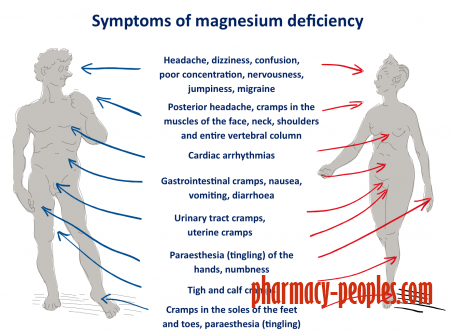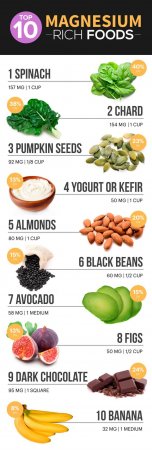22 Signs That You Immediately Need Magnesium And How To Get It
Who would have thought that the lack of only one nutrient can have an enormous impact on the overall health?
Every single cell in the body needs magnesium to function properly, and it’s responsible for over 300 metabolic functions in the body. It’s clear that this element is vital for your health, but according to USDA, approximately a half of the Americans consume inadequate amount in their diet.
Functions of magnesium
The functions of magnesium in the human body is complex and sophisticated. But, some of the main functions include:
As a cofactor, enabling thousands of biochemical processes, including temperature regulation, breaking down of glucose and fat, production of proteins, antioxidants, cholesterol, and the creation of DNA and RNA.
Produces energy inside mitochondria, metabolizing them into usable energy and storing them. When magnesium level is low, one can expect to feel lethargic.
Magnesium is a cofactor for dozens of various other nutrients to be used as building blocks to create the body structure.
Magnesium is necessary for electrical transmission of our thoughts to the nervous system and to various parts of our body.
While calcium causes contraction of muscles, magnesium causes relaxation. In the presence of excess calcium and insufficient magnesium, crampings (of the lungs, uterus, blood vessels, legs, muscles, etc.) can occur.
Magnesium is required to maintain a healthy balance (homeostasis) of the body’s electrolytes-calcium, sodium, potassium-that affects nerve impulses, muscle contractions, and heart rhythms.
Sufficient magnesium is essential to achieving the delicate balance necessary to keep the smooth-running of all these body’s functions. So you can see, in cases of magnesium deficiency, there can be far-reaching implications for the body’s level of performance and health. Body processes and metabolism could easily spiral out of control.
Why do you get magnesium deficient
Some of the factors that cause magnesium deficiency include:
Soil that is deficient in minerals produce foods that are low in magnesium content.
Eating foods that are high in calcium. Calcium requires magnesium at the ratio of 1:1 in order to be absorbed.
Long-term medication (of any drugs) and stress deplete the body of magnesium.
Inefficient intestinal absorption hinders absorption of magnesium, even when ingesting foods high in magnesium.
Excessive consumption of high fat food, processed foods, sodas, salt and sugar-not only are these foods void of magnesium but in order to digest them, they further deplete the body of magnesium.
Drinking water that is fortified with fluoride that depletes the body of magnesium.
Symptoms of magnesium deficiency
Early signs of magnesium deficiency include muscle twitching (noticeably on the eyelid), loss of appetite, headache, nausea, fatigue, and weakness.
An ongoing magnesium deficiency can lead to more serious symptoms, including:
Numbness and tingling
Muscle contractions and cramps
Seizures
Abnormal heart beat rate
Coronary spasms
Anxiety
As magnesium is necessary in so many bodily functions and processes, the lack of it will easily spiral things out of control.
Some of the conditions that are linked to magnesium deficiency have been recorded as follows:
Anxiety, depression, confusion, anger
Asthma
Atherosclerosis and arteriosclerosis
Cardiac arrhythmias
High cholesterol
Chronic fatigue syndrome
Coronary heart disease
Type 2 diabetes
Epilepsy
Fibromyalgia
Hypertension
Infertility
Inflammatory diseases
Insomnia and other sleep disorders
Kidney stones
Migraines and headaches
Muscle pain and cramps
Nervousness
Obesity
Osteoporosis
PMS, PCOS
Stroke
If you suspect that you’re magnesium-deficient, first of all work to reduce the factors in your lifestyle or diet that contribute to the deficiency where possible. Magnesium is best available from food sources and from supplements.
Green leafy vegetables aren’t the only foods rich in magnesium and chlorophyll. Here are the top 10 foods high in magnesium that you will want to add into your diet.
(Men RDA 400 milligrams and Women RDA 310 milligrams a day)
Other foods that are also high in magnesium include: salmon, coriander, cashews, goat cheese and artichokes.
Every single cell in the body needs magnesium to function properly, and it’s responsible for over 300 metabolic functions in the body. It’s clear that this element is vital for your health, but according to USDA, approximately a half of the Americans consume inadequate amount in their diet.
Functions of magnesium
The functions of magnesium in the human body is complex and sophisticated. But, some of the main functions include:
As a cofactor, enabling thousands of biochemical processes, including temperature regulation, breaking down of glucose and fat, production of proteins, antioxidants, cholesterol, and the creation of DNA and RNA.
Produces energy inside mitochondria, metabolizing them into usable energy and storing them. When magnesium level is low, one can expect to feel lethargic.
Magnesium is a cofactor for dozens of various other nutrients to be used as building blocks to create the body structure.
Magnesium is necessary for electrical transmission of our thoughts to the nervous system and to various parts of our body.
While calcium causes contraction of muscles, magnesium causes relaxation. In the presence of excess calcium and insufficient magnesium, crampings (of the lungs, uterus, blood vessels, legs, muscles, etc.) can occur.
Magnesium is required to maintain a healthy balance (homeostasis) of the body’s electrolytes-calcium, sodium, potassium-that affects nerve impulses, muscle contractions, and heart rhythms.
Sufficient magnesium is essential to achieving the delicate balance necessary to keep the smooth-running of all these body’s functions. So you can see, in cases of magnesium deficiency, there can be far-reaching implications for the body’s level of performance and health. Body processes and metabolism could easily spiral out of control.
Why do you get magnesium deficient
Some of the factors that cause magnesium deficiency include:
Soil that is deficient in minerals produce foods that are low in magnesium content.
Eating foods that are high in calcium. Calcium requires magnesium at the ratio of 1:1 in order to be absorbed.
Long-term medication (of any drugs) and stress deplete the body of magnesium.
Inefficient intestinal absorption hinders absorption of magnesium, even when ingesting foods high in magnesium.
Excessive consumption of high fat food, processed foods, sodas, salt and sugar-not only are these foods void of magnesium but in order to digest them, they further deplete the body of magnesium.
Drinking water that is fortified with fluoride that depletes the body of magnesium.
Symptoms of magnesium deficiency
Early signs of magnesium deficiency include muscle twitching (noticeably on the eyelid), loss of appetite, headache, nausea, fatigue, and weakness.
An ongoing magnesium deficiency can lead to more serious symptoms, including:
Numbness and tingling
Muscle contractions and cramps
Seizures
Abnormal heart beat rate
Coronary spasms
Anxiety
As magnesium is necessary in so many bodily functions and processes, the lack of it will easily spiral things out of control.
Some of the conditions that are linked to magnesium deficiency have been recorded as follows:
Anxiety, depression, confusion, anger
Asthma
Atherosclerosis and arteriosclerosis
Cardiac arrhythmias
High cholesterol
Chronic fatigue syndrome
Coronary heart disease
Type 2 diabetes
Epilepsy
Fibromyalgia
Hypertension
Infertility
Inflammatory diseases
Insomnia and other sleep disorders
Kidney stones
Migraines and headaches
Muscle pain and cramps
Nervousness
Obesity
Osteoporosis
PMS, PCOS
Stroke
If you suspect that you’re magnesium-deficient, first of all work to reduce the factors in your lifestyle or diet that contribute to the deficiency where possible. Magnesium is best available from food sources and from supplements.
Top 10 Magnesium Rich Foods
Green leafy vegetables aren’t the only foods rich in magnesium and chlorophyll. Here are the top 10 foods high in magnesium that you will want to add into your diet.
(Men RDA 400 milligrams and Women RDA 310 milligrams a day)
- Spinach — 1 cup: 157 milligrams (40% DV)
- Chard — 1 cup: 154 milligrams (38% DV)
- Pumpkin seeds — 1/8 cup: 92 milligrams (23% DV)
- Yogurt or Kefir — 1 cup: 50 milligrams (13% DV)
- Almonds — 1 ounce: 80 milligrams (20% DV)
- Black Beans — ? cup: 60 milligrams (15% DV)
- Avocado — 1 medium: 58 milligrams (15% DV)
- Figs — ? cup: 50 milligrams (13% DV)
- Dark Chocolate — 1 square: 95 milligrams (24% DV)
- Banana — 1 medium: 32 milligrams (8% DV)
Other foods that are also high in magnesium include: salmon, coriander, cashews, goat cheese and artichokes.



